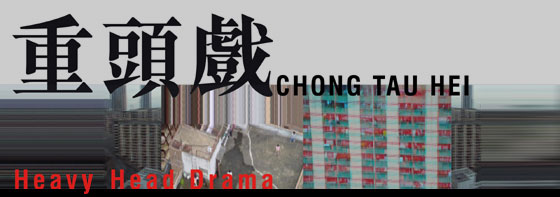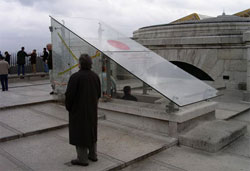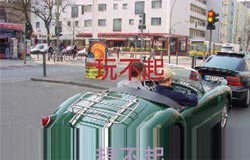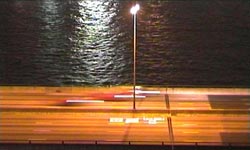Ellen Pau is a major figure in
the world of video art in Asia. Herwork is on display at numerous international
art-shows.
"
Heavy Head Drama", her solo exhibition at PLAY, assembles
three video and installation works that never before have been shown in
Germany:
Not Yet (2003)
For Some Reasons (2003)
Recycling Cinema (2000)
“Nam-June Paik subverts the information content of his imagery by
a strategy of over-load, but Ellen Pau achieves the same end by moving
in the opposite
direction.” David Clarke, 2nd Asian Pacific Triennal, catalogue,
Brisbane.
Ellen Pau's strong sense for aesthetics and rhythm forms the base
for her skilful
transformation of political news, events and emotions into artwork. Hong
Kong born Ellen Pau can be seen to mirror the history of her hybrid hometown,
or - to use the modest Chinese way of saying - a little part of history,
that, by means of her video and installation work, finally turns his-story
into her-story.
The title "Heavy Head Drama" is the literal
translation of the Chinese saying "Chong Tau Hei", a fixed term
to describe the main plot or the most important scene of a dramatic story.
It refers to a style of translation which draws its ambivalence and manufactures
its puns from the curious mixing of levels, like the sound of the pronounced
Cantonese, the use of western letters to describe the sound and the original
meaning of the Chinese characters. “Chong Tau Hei” could for
example as well be read as “Plenty Beginning Play”. "Heavy
Head Drama" is about literal translation, mixing language and sound,
stories and real lives, misunderstanding and communication.
The complex qualities of Chinese language carrying sound, form, structure
and meaning, are usually only selectively represented in the translation. "Hong
Kong", for example, usually was translated to a sound while it does
not say anything about the meaning, "Fragrance Harbour". Yet
the loss of meaning in the process of translation is often the mysterious
flare of the text. Sill images, movie language, as well as motion graphics
also have complex qualities of their own. "Not Yet" is the post
text, a kind of translation of "For Some Reason". It is an exploration
of translation between image, text and sound, of the transaction of interpretation.
"For Some Reasons" starts with the exploration of the figure
of speech. Every Chinese character is a face, each face has a story. Put
the faces
together you end up having another story. As a reaction on public demonstrations
the title of the work copies a phrase that has been liberately used by
Hong Kong government officials, when talking about the recently issuednationalsecurity
laws in China’s Special Administration Zone.The text of the story
responses to the new controversially discussed Article 23, mixing with
the hot topics of Hong Kong People.The pictures is made up of animated
still frame pictures that is resembling the Chinese still frame character.
The third work included in the show is the installation "Recycling
Cinema", a continuation of Ellen Pau’s longstanding interest
in exploring different ways in which to frame the spatial and temporal
aspects of mobility and location in an urban context. Addressing the theme
of observation and participation, reality and representation, the installation
is a subtle, restraint critique of the use of hypertransgressive metaphors--idealizations
of extreme and incessant mobility - in the representation of global cities
such as Hong Kong. In contrast to electronic travelogues that
merely record the fast-paced rhythm of everyday life in the city’s
busy streets, it patiently excavates the banal act of observing traffic
passing through a lonely highway by the sea. It attempt to reduce the excesses
of speed, information, and media flows, to come to an alternative peaceful,
quiet cognition of space and pictorial organization of the moving image.
Mesmerizing and captivating, the temporal and spatial shifts created within
the video image, as well as by its projected movement back and forth along
a wide arched screen, calls for a heightened awareness of individual vehicles
rushing past as objects of desire.
Composed by Elaine Ng, Dorotea Etzler and Alice Ming Wai Jim. |



